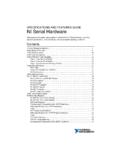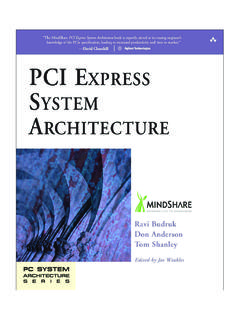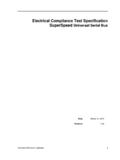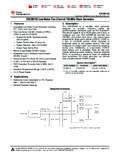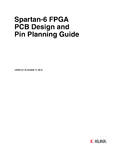Transcription of ARINC825 - stockflightsystems.com
1 Page 1 of 19(C) 2008-2010 Innovative Control Systems, Stock Flight Systems, Wetzel TechnologyARINC 825 PresentationARINC825 General Standardization of CAN (Controller Area Network)Bus Protocol for Airborne UseBO105page 2 of 19(C) 2008-2010 Innovative Control Systems, Stock Flight Systems, Wetzel TechnologyARINC 825 PresentationWhat is ARINC825 ? The ARINC825 standard (General Standardization of Controller Area Network Bus Protocol for Airborne Use) was mainly driven by Airbus and Boeing and defines a communication standard for airborne systems using Controller Area Network (CAN), which has been identified by both leading airframers as an important baseline network for their future transport aircraft. ARINC825 was developed by the CAN Technical Working Group of the Airlines Electronic Engineering Committee (AEEC) Aircraft Network Infrastructure and Security Subcommittee that included members from Airbus, Boeing, Rockwell Collins, GE Aerospace and Stock Flight Systems and was first published November 15, 2007.
2 The second revision will be released by January, 2010. The ARINC825 communication mechanism was derived from the well-established CANaerospace standard and is suitable for large transport, general aviation and military aircraft. Compatibility between CANaerospace and ARINC825 is given. ARINC825 constitutes the framework for all other ARINC Standards based on CAN. Examples for ARINC825 -based standards are the ARINC826 Dataload and ARINC812 Galley Insert Communication 3 of 19(C) 2008-2010 Innovative Control Systems, Stock Flight Systems, Wetzel TechnologyARINC 825 PresentationDesign Targets of ARINC825 ARINC825 was designed to be used as a primary or ancilliary network for general aviation, air transport and military aircraft. ARINC825 ensures:1.)Minimal cost of implementation and cost of change over time2.)Maximum interoperability and interchangeability of CAN connected LRUs3.)Configuration flexibility: easy addition, deletion, and modification of bus nodes, without undue impact to other LRUs4.
3 Interconnection of systems5.)Easy connections of local CAN networks to other airplane networks6.)Traffic to easily cross system and network boundaries for both parametric and block data transfers7.)Integrated error detection and error signaling8.)System level functions such as on-board data load and airplane health management can be implementedpage 4 of 19(C) 2008-2010 Innovative Control Systems, Stock Flight Systems, Wetzel TechnologyARINC 825 Presentation Concept definition, role of CAN in aircraft communications Data flow, network domain characteristics, bus topology CAN physical layer, transceiver requirements, bus speed Cabling, connectors, installation Data link layer, ISO compliance, error handling Protocol concept (anyone-to-many and peer-to-peer communication) CAN identifier usage, logical communication channel definition Payload data formats, physical units, axis and sign conventions Communication profile definition Network quality indication support Node service concept Test & Maintenance support Message prioritization and bandwidth managementStandardization Issues covered by ARINC825 PhysicalCharacteristicsInteroperabilityT est &Maintenancepage 5 of 19(C) 2008-2010 Innovative Control Systems, Stock Flight Systems, Wetzel TechnologyARINC 825 Presentation From an overall aeronautical system architecture view, there are general network domains that fall under ARINC664 as Ethernet based networks and ARINC825 as CAN based networks.
4 ARINC825 addresses the access to and data flow over CAN and also across network boundaries (domains). ARINC825 supports the data flow across domains through gateways. Cross-domain communication is accomplished by logical communication channel definitions, individual station addressing capabilities and one-to-many/peer-to-peer communication mechanisms (which are not part of the bare CAN Standard). ARINC825 also gives extensive design guidelines for the implementation of gateways for cross-domain communication with respect to bandwidth capacity and other Network Domainspage 6 of 19(C) 2008-2010 Innovative Control Systems, Stock Flight Systems, Wetzel TechnologyARINC 825 Presentation ARINC825 is based on CAN extended frames (29-bit identifiers) exclusively. CAN protocols based on standard frames (11-bit identifiers) can be used with ARINC 825 if they are free of potential deadlock scenarios caused by single source bus masters, etc.
5 To ensure interoperability and reliable communication, ARINC825 specifies the electrical characteristics, bus transceiver requirements and data rates with the corresponding tolerances. The bit timing calulation (baud rate accuracy, sample point definition) and electromagnetic interference problems are given special emphasis. Also addressed within ARINC825 are CAN connectors and wiring considerations. The data rates supported by ARINC825 are:a.)1000 kBit/sb.)500 kBit/sc.)250 kBit/sd.)125 kBit/se.) kBit/sARINC825 Physical Layer Definitionspage 7 of 19(C) 2008-2010 Innovative Control Systems, Stock Flight Systems, Wetzel TechnologyARINC 825 PresentationCAN Baud Rate vs. Bus Lengthpage 8 of 19(C) 2008-2010 Innovative Control Systems, Stock Flight Systems, Wetzel TechnologyARINC 825 Presentation CAN according to ISO 11898-1 and ISO 11898-2 provides ISO layer 1 and 2 definitions only. For ARINC825 , ISO additional layer 3, 4 and 6 functions have been added to support logical communication channels, one-to-many/peer-to-peer communication and station addressing.
6 To accomplish this, the 29-Bit CAN identifier is given a special structure for Communication (1)layer 1 (physical layer)layer 2 (data link layer) layer 3 (network layer) layer 5 (session layer) layer 6 (presentation layer) layer 7 (application layer) connectors, cables,voltage levels, ..error detection,login, session dialogdata block synchronisation, ..data representation,set of user-definedrouting, data packetflow control, ..control, ..data standardization, ..application functionsNetworkuser applicationCANlayer 4 (transport layer) logical channels, datatransmission retries, ..networknodeAdditional Functionspage 9 of 19(C) 2008-2010 Innovative Control Systems, Stock Flight Systems, Wetzel TechnologyARINC 825 PresentationARINC825 Communication (2) ARINC825 Logical Communication Channels (LCCs) provide independant layers of communication:ChannelNumberChannelAcrony mDescriptionLCC BitsMessage Priority0 EECE mergency Event Channel000 Highest1 Reserved0012 NOCN ormal Operation Channel0103 Reserved0114 NSCNode Service Channel1005 UDCUser-Defined Channel1016 TMCTest and Maintenance Channel1107 FMCCAN Base Frame Migration Channel111 Lowest073115162324829-Bit CAN Identifierpage 10 of 19(C) 2008-2010 Innovative Control Systems, Stock Flight Systems, Wetzel TechnologyARINC 825 Presentation The identifier structure for one-to-many communication supports broadcast data communication.
7 Additional fields within the identifier provide information to make correct use of the data object at the receiving end:a.)FID = Function Code Identifier (Identifies the source of the message)b.)RSD = Reservedc.)LCL = Local (Indicates that message destination is the local bus segment only)d.)PVT = Private (Indicates that the message is for special use only)e.)DOC = Data Object Code (Identifies the message payload)f.)RCI = Redundancy Channel Identifier (Identifies one of four redundant sources) ARINC825 Communication (3)0731151623248 LCCDOCPVTLCLRSDS ource FIDRCI page 11 of 19(C) 2008-2010 Innovative Control Systems, Stock Flight Systems, Wetzel TechnologyARINC 825 Presentation The identifier structure for peer-to-peer communication supports station addressing: Peer-to-peer communication allows individual nodes on a CAN network or across network domains to establish client/server type interactions, called node services.
8 Both connectionless and connection-oriented communication (compare to UDP/IP vs. TCP/IP) is supported. The Node-ID (NID) allows to address up to 512 different nodes (servers, SID) in each of the 128 different functions (Server FID). ARINC825 includes a list of predefined and user-defined functions (FIDs). ARINC825 Communication (4)07158 Server FIDSID31162324 Client FIDLCCPVTLCLSMTNIDRCI page 12 of 19(C) 2008-2010 Innovative Control Systems, Stock Flight Systems, Wetzel TechnologyARINC 825 Presentation To provide a high degree of interoperability, ARINC825 includes:a.)Data Endian definition (Big Endian exclusively)b.)Data Type definition (Boolean, Integer, Floating-Point, ..)c.)Aeronautical Axis System and Sign Conventiond.)Engineering Unit definitione.)Aircraft Function definition (Flight State, Air Data, ..) ARINC825 Message Payload Standardizationpage 13 of 19(C) 2008-2010 Innovative Control Systems, Stock Flight Systems, Wetzel TechnologyARINC 825 Presentation ARINC825 sets forth a concept for message prioritization and bandwidth management.
9 This concept provides a straightforward means of computing the bus load based on the number of messages in a network segment and adjusting their transmission Bandwidth Management Concept The ARINC825 Bandwidth Management Concept minimizes peak load scenarios and jitter caused by the CAN bus arbitration. Applying this concept, it can be demonstrated that ARINC825 networks fullfil the requirements for flight safety critical systems up to Design Assurance Level Node 1 Minor TimeFrame #nMinor TimeFrame #n+1 Minor TimeFrame #n+2 Minor TimeFrame #n+3 CAN Node 2 Minor TimeFrame #nMinor TimeFrame #n+1 Minor TimeFrame #n+2 Minor TimeFrame #n+3 ResultingBus Trafficpage 14 of 19(C) 2008-2010 Innovative Control Systems, Stock Flight Systems, Wetzel TechnologyARINC 825 Presentation ARINC825 uses a Communication Profile database for the description of entire networks. The Communication Profile database uses readable XML files and describes the network traffic in detail.
10 Communication Profiles provide a valuable means for specification and verification of ARINC825 systems and allow to detect potential network problems at an early stage. ARINC825 test tools must be able to read Communication Profiles and display network data Communication Profilepage 15 of 19(C) 2008-2010 Innovative Control Systems, Stock Flight Systems, Wetzel TechnologyARINC 825 Presentation PMC form factor 64-bit, 66 MHz bus mastering PCI interface 4 optically isolated (or 8 non-isolated) ARINC 825 interfaces per module Bosch CAN controller IP cores implemented in Xilinx Virtex-4 FX60 FPGA Dual on-chip 200 MHz PowerPC processors True dual-ported RAM interface between host CPU and ARINC825 data GPS 1 PPS inputs PMC carriers for platform diversity (PCI, cPCI, PCI-X, PCI Express, VME) Module firmware supports record/playback functions and high resolution timestamping Software drivers for Linux/X86, Solaris/SPARC, VxWorks and Windows XP/V7 PMC825 Modulepage 16 of 19(C)


